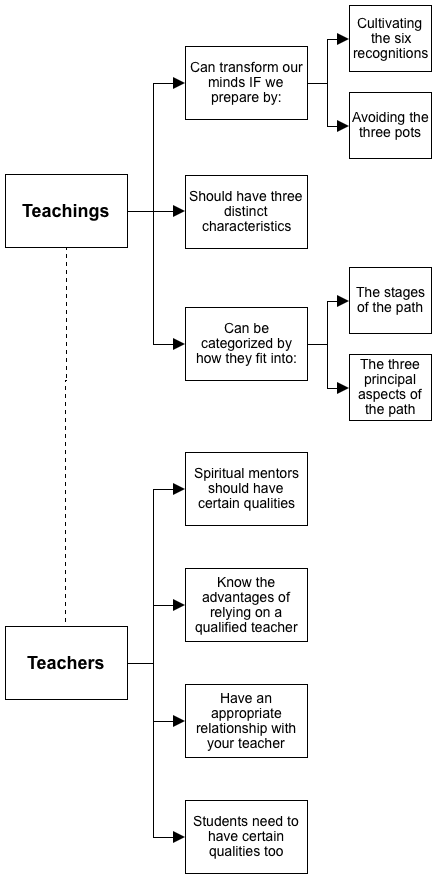Week 1 Summary Diagram

Related Diagrams
The Topics
 The Six Recognitions
The Six Recognitions
- Seeing ourselves as a sick person in cyclic existence
- Seeing the teacher (and the Buddha) as a skilled doctor
- Seeing the Dharma as the medicine to cure our illness
- Seeing the practice of the Dharma as the actual method to cure it
- Seeing the Buddha as the supreme, non-deceptive guide and doctor
- Praying for this path to be preserved and flourish
 The Three Pots
The Three Pots
- The upside-down pot: Nothing gets in because we’re asleep or distracted.
- The pot with the hole in the bottom: We’re awake, we’re listening, but we can’t remember what was said.
- The dirty pot: Even if you pour in something pure, it gets polluted; pure teachings are contaminated by wrong motivations.
 Three Distinguishing Characteristics of Teachings
Three Distinguishing Characteristics of Teachings
The teachings we should listen to and practice have three distinguishing characteristics:
- They have been taught by the Buddha.
- They are clean of any errors.
- They have been realized by the great masters.
 The Stages of the Path
The Stages of the Path
The Buddha’s teachings or sutras were passed down orally until they were written down in the first century B.C.E.
- In subsequent centuries, Indian scholar-practitioners wrote treatises that compiled and systematized the sutras’ important points.
- As Buddhism spread to other areas, other scholar-practitioners continued to clarify points and make the materials accessible to the people of those times via commentaries.
- In Lamp of the Path, Atisha described three levels of spiritual practitioners—initial, middle, and advanced—each with its own aspiration, method to cultivate that aspiration, and practices to do to actualize that aspiration, once cultivated.
- Later generations of Tibetan sages, in particular Je Tsongkhapa (1357-1419), systematized the teachings further, forming the lamrim—the stages of the path to enlightenment. The lamrim presents a step-by-step method to tame the mind.
 The Three Principal Aspects of the Path
The Three Principal Aspects of the Path
- Renunciation—the determination to be free
- Bodhicitta—the altruistic intention to attain enlightenment in order to most effectively benefit all sentient beings
- Wisdom—the correct view of emptiness, the lack of inherent existence
 Important Qualities of Spiritual Mentors
Important Qualities of Spiritual Mentors
To progress on the path, rely upon and be guided by qualified spiritual mentors with many of the following qualities:
- stable practice or realization of the three higher trainings (ethical conduct, meditative stabilization, wisdom)
- vast and deep knowledge of the scriptures
- joy and enthusiasm to teach
- ability to express the teachings clearly
- loving concern and compassion for students
- patience
 The Advantages of Relying on a Qualified Spiritual Mentor
The Advantages of Relying on a Qualified Spiritual Mentor
Consider the advantages to relying on a qualified teacher:
- You will learn correct teachings and practice methods.
- You will gain realizations and approach enlightenment.
- You will avoid unfortunate rebirths.
- You will have spiritual teachers in your future lives.
Consider also the disadvantages of not properly relying on a teacher:
- None of the above benefits will accrue.
- You’ll continue in cyclic existence, especially in unfortunate rebirths.
- Even if you try to practice, your practice may not be successful.
- Your good qualities may decline.
 Appropriate Teacher-Student Relationships
Appropriate Teacher-Student Relationships
Cultivate a relationship with your teachers that is imbued with faith, respect, and gratitude, so that you will progress easily and steadily on the path to enlightenment.
We cultivate our relationship with our spiritual teacher through our actions by making material gifts, by offering them our services, and especially by practicing the teachings they have given us.
 Important Qualities of Students
Important Qualities of Students
Promising students are open-minded and unprejudiced.
- They are not attached to their own views or culture nor are they hostile to others’ views.
- They are able to differentiate between valuable instructions and those which only appear good.
- They are enthusiastic and persevering.
- They also need respect and faith.